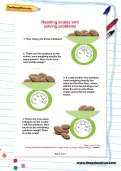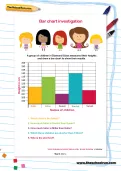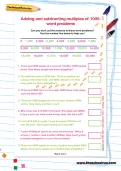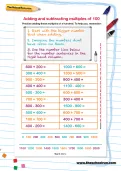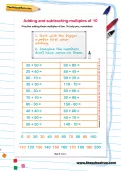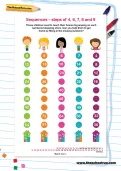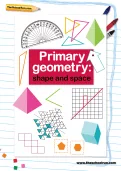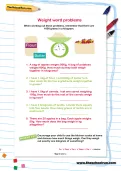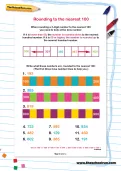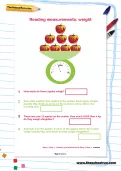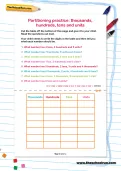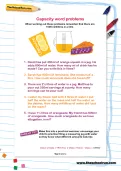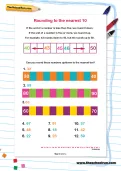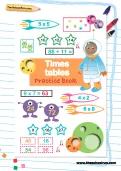A group of children in Diamond Class measured their heights and drew a bar chart to show their results. 1. Which child is the tallest? 2. How much taller is Rachel than Susan? 3. How much taller is Millie than Katie? 4. Which three children are shorter than 130cm? 5. Who is the shortest?
or
Register to add to your saved resources
Already a subscriber? to view this content.
Can you work out the answers to these word problems? Use the number line to help you!
or
Register to add to your saved resources
Already a subscriber? to view this content.
Practise adding these multiples of a hundred. To help you, remember: 1. Start with the bigger number first when adding. 2. Imagine the numbers don’t have zeros on them. 3. Use the number line for the number sentences in the right hand column.
or
Register to add to your saved resources
Already a subscriber? to view this content.
Practise adding these multiples of ten. To help you, remember: 1. Start with the bigger number first when adding. 2. Imagine the numbers don’t have zeros on them.
or
Register to add to your saved resources
Already a subscriber? to view this content.
Can you work out these sums? Try out several combinations until you get the right one and remember to jot things down as you go, so you don’t forget where you are up to.
or
Register to add to your saved resources
These children need to reach their homes by jumping on each numbered stepping stone. Can you help them to get home by filling in the missing numbers?
or
Register to add to your saved resources
Already a subscriber? to view this content.
Look at these pictures and see how much each item weighs. Don’t forget to use the correct unit of measurement!
or
Register to add to your saved resources
Already a subscriber? to view this content.
Do you know your hexagons from your heptagons, your pentagonal pyramids from your octagonal prisms? From 2D shapes to angles and symmetry our seventy-page Primary Geometry: shape and space learning pack covers all aspects of the national curriculum (Shape and Space) and will ensure your child can use a protractor, translate a shape and look for a mirror line. Challenge them to a game of 3D shape dominoes, make a right-angle measurer and get started!
or
Register to add to your saved resources
Already a subscriber? to view this content.
Can you work out these weight word problems? Remember that there are 1000 grams in a kilogram...
or
Register to add to your saved resources
Already a subscriber? to view this content.
When rounding a 3-digit number to the nearest 100 you need to look at the tens number. If it is lower than 50, the number is rounded down to the nearest hundred number. If it is 50 or higher, the number is rounded up to the nearest hundred number. Can you write what these numbers are, rounded to the nearest 100?
or
Register to add to your saved resources
Already a subscriber? to view this content.
Can you read measurements in grams and kilograms? Let's find out.
or
Register to add to your saved resources
Already a subscriber? to view this content.
Use this metre ruler to measure in centimetres and metres.
or
Register to add to your saved resources
Already a subscriber? to view this content.
Do you know your litres from your millilitres? Test yourself with these questions.
or
Register to add to your saved resources
Already a subscriber? to view this content.
Listen to these numbers then write each digit in the correct column – thousands, hundreds, tens or units.
or
Register to add to your saved resources
Already a subscriber? to view this content.
Can you work out these word problems? Remember that there are 100 centimetres in one metre. There are 1000 metres in one kilometre.
or
Register to add to your saved resources
Already a subscriber? to view this content.
Here are some tricky problems that involve capacity. You can fill a measuring jug with water to help you work them out.
or
Register to add to your saved resources
Already a subscriber? to view this content.
Revise the rule about when to round numbers up and when to round them down and put the theory into practice with some rounding activities.
or
Register to add to your saved resources
Already a subscriber? to view this content.
Make times tables revision easy by downloading our 90-page practice book. It covers all the tables from 2 to 12 and offers quizzes, speed challenges and more to help your child master this vital area of primary maths. Practice makes perfect!
or
Register to add to your saved resources
Already a subscriber? to view this content.
Practise telling the time to forty-five minutes past the hour with this time worksheet. Your child will need to match the same 'quarter to' the hour times shown on a digital and analogue clock.
or
Register to add to your saved resources
In Year 2 children learn to tell the time to quarter past and quarter to the hour. Help them practise with this simple matching worksheet.
or
Register to add to your saved resources
Already a subscriber? to view this content.
